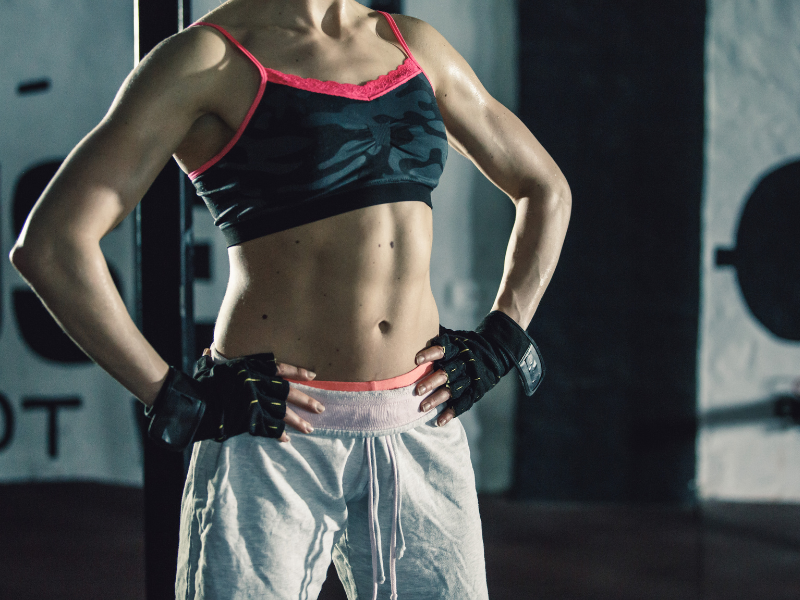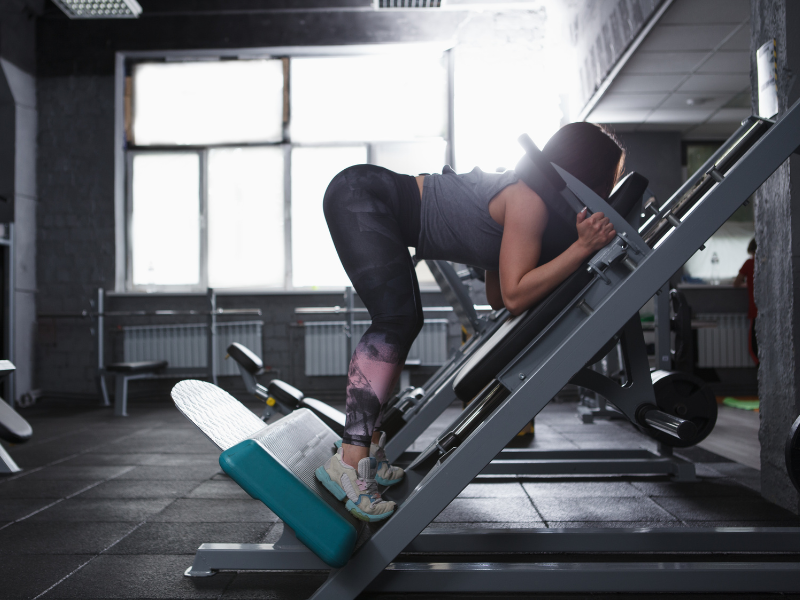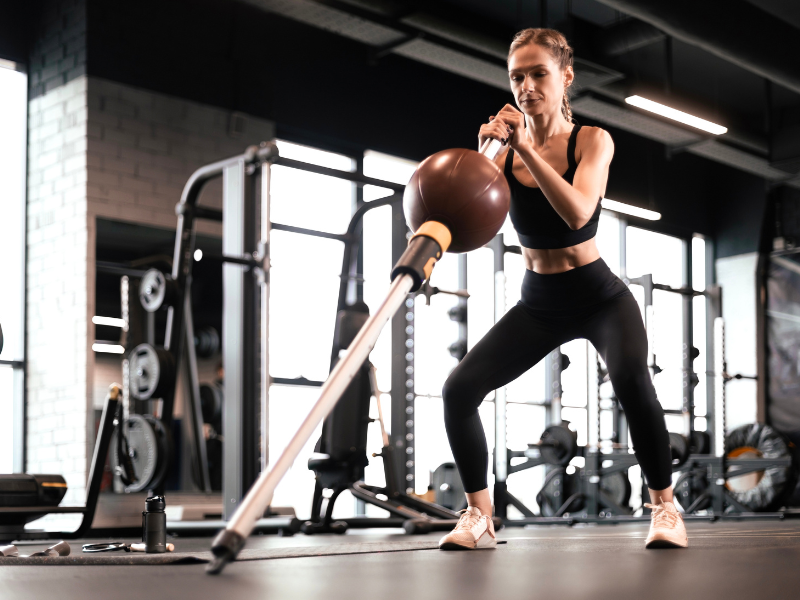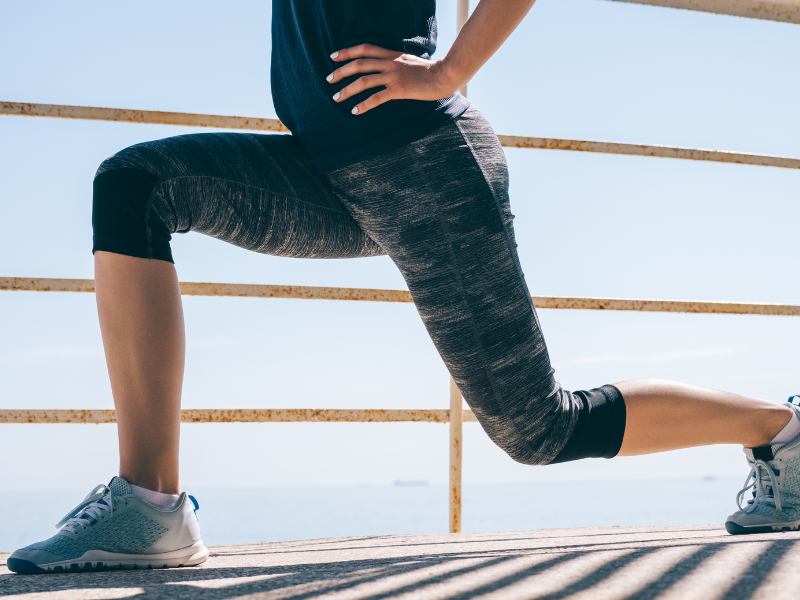




To achieve a well-defined and balanced physique, hitting the legs is a must! One powerhouse exercise for building killer lower body muscles is the reverse hack squat.
This variation of the classic hack squat is fantastic for sculpting your quads while firing up your hamstrings and glutes [1]. By pushing the weights with your shoulders and chest on the hack machine, you not only work your legs but also give your core a solid workout. Ready to take your leg training to the next level? Keep reading for the ultimate guide on mastering this game-changing move!
What Muscles Does the Reverse Hack Squat Work?

This workout goes beyond just targeting the quads—it also strengthens the hamstrings, glutes, and core. While the hack machine is typically used for anterior-focused lower-body training, the reverse hack squat variation shifts the focus to the posterior chain. Proper positioning at the hip joint is crucial for executing the movement effectively and avoiding undue stress on the knee joints.
This movement effectively engages multiple muscle groups simultaneously, making it one of the best exercises for rapidly increasing muscle size and overall strength. Similar to leg presses, which also target the quads, glutes, and hamstrings, the reverse hack squat differs in execution and the use of external weights.
- Primary muscles worked: Quads, Glutes, Hamstrings
- Secondary muscles worked: Upper Back, Core
- Equipment: A hack squat machine
- Calories Burned: 50-100 cal (10 minutes)
How To Do Reverse Hack Squats
To perform a reverse hack squat, you will need a hack squat machine. Here are the steps to follow:
- Stand facing away from the hack squat machine, with your feet shoulder-width apart and your toes pointing forward.
- Place your upper thighs on the padded lever of the hack squat machine, with your feet pressing against the platform. Your knees should be bent at a 90-degree angle.
- Hold onto the handles of the machine for support, and extend your legs to push the platform away from your body.
- Slowly lower the platform back to the starting position, allowing your knees to bend as you do so.
- Repeat the movement for the desired number of repetitions.
Make sure to keep your back straight and your feet firmly planted on the platform throughout the exercise. It’s also important to control the movement and avoid locking your knees at the top of the movement. This can help prevent injury and ensure that you are targeting the muscles in your legs effectively. Avoid lifting too much weight to reduce the risk of injury and enhance performance and safety by enabling more repetitions with proper technique.
Sets And Reps
To build muscle, it’s best to work out with weights that are heavy enough for you to do more than 10 repetitions. Three to five sets of 10 or more reps are usually effective. Using more weight during exercises like squats and reverse hack squats can lead to better muscle engagement and results.
Reverse Hack Squat Benefits

The reverse hack squat primarily targets the quadriceps, the muscles located at the front of the thighs. This exercise is excellent for enhancing muscle strength and definition, as well as increasing overall leg size. Additionally, it improves lower body strength and stability, benefiting various other exercises and activities.
- Boost Athletic Performance: Strong quadriceps contribute to better performance in activities that demand lower body strength, such as running, jumping, and cycling.
- Enhance Posture: Well-developed quadriceps support your upper body weight and help improve posture.
- Reduce Injury Risk: Strong quadriceps support your joints, lowering the risk of injuries, particularly to the knees and hips.
- Increase Flexibility: The reverse hack squat enhances the flexibility of your quadriceps and hips, which can improve your range of motion and decrease muscle stiffness or soreness.
Reverse Hack Squat Alternatives
If you can’t do a machine hack squat, there are still ways to get some of the benefits of the hack squat. The 5 best hack squat alternatives are:
- Leg press
- Front squats
- Lunges
- Shrimp squat
- Squat jacks
1. Leg press
The leg press is a machine-based exercise that can be performed using a seated or lying position. It involves pushing a platform away from your body using your legs. This exercise can be used to target the quadriceps, as well as the glutes and hamstrings.
2. Front squats
Front squats are similar to hack squats, but instead of pushing the platform away from your body, you hold a barbell or dumbbells in front of your chest. This can help to improve upper body strength and stability, as well as target the quadriceps.
3. Lunges
Lunges are a versatile exercise that can be performed with or without weights. They involve stepping forward and lowering your body until your back knee almost touches the ground. This exercise targets the quadriceps, as well as the glutes and hamstrings.
4. Shrimp squats
The shrimp squat is a type of bodyweight exercise that involves squatting down on one leg while raising the other leg out to the side. This exercise is designed to improve balance and stability, and to target the muscles in the legs and hips.
5. Squat jacks
Squat jacks, also known as jumping jacks or star jumps, are a type of plyometric exercise that involves jumping and spreading your legs and arms out to the side. This exercise is designed to improve cardiovascular endurance and coordination and to target the muscles in the legs and arms.
Reverse Hack Squat Variations
Hack Squat Variation With Pointed Toes
This straightforward variation involves flexing and pointing your toes outward with each repetition. While it may seem like a minor adjustment, it can significantly impact the inner part of your quadriceps and engage your adductors (inner thigh muscles) more effectively. This can enhance muscle balance in the inner thigh region. To incorporate this variation, simply perform the reverse hack squat as usual, but ensure that your toes are pointed outward for each rep.
Landmine Squat

The landmine squat shares similarities with the reverse hack squat, but instead of resting the weight on your back, it is supported on your sternum. The load in a landmine squat has a pendulum effect, swinging out toward you. This exercise is particularly beneficial for those with back issues, as it places less strain on the back. However, a notable drawback is that you can’t load the bar too heavily, as you need to lift it to your chest and place it down smoothly.
Barbell Hack Squat
The barbell hack squat is a popular variation of the reverse hack squat. The main difference is that, instead of placing the weight on your shoulders, you lift a barbell from behind your legs. This setup enhances grip strength but might limit the amount of weight you can lift compared to using a hack squat machine. Unlike the barbell hack squat, the original hack squat primarily focuses on the quadriceps due to its knee flexion mechanics.
Common Mistakes in Reverse Hack Squat
Maintaining proper reverse hack squat form is crucial to avoid common mistakes and maximize effectiveness. Here are some key tips to keep in mind for optimal results when performing the reverse hack squat:
- Avoid overextending your lower back, as this can cause your upper body to lean forward and put unnecessary stress on your lower back [2]. Instead, keep your upper body close to the wall to ensure your glutes properly support the weight.
- To continue making gains, progressively increase the weight as you become more comfortable with your current load. Sticking with the same weight can hinder your progress.
- Ensure your lower back remains straight and avoid rounding it. Don’t use excessive momentum to lift the weight, and keep your heels firmly planted on the ground.
- Concentrate on engaging the specific muscle group you’re targeting rather than trying to work multiple muscle groups simultaneously. This focus will enhance the effectiveness of the exercise and prevent wasted effort.
By following these guidelines, you can maximize the effectiveness of your reverse hack squats and achieve better results.
Related Lower Body Exercises

Here are some other lower body exercises that will help you strengthen, sculpt and tone your thighs, hips, legs, and glutes:
- Leg raises
- Flutter kicks
- Single-leg lunge
- Lunges
Conclusion
We hope this article has given you all the essential information about the reverse hack squat. Remember, this is an intermediate-level exercise, so some experience is recommended before giving it a try. If you’re unsure or need personalized guidance, consulting a professional trainer can be a great option. For additional workout tips and exercise plans to support a healthier lifestyle, be sure to check out the JustFit app!
How do you hack squats without a hack squat machine?
How deep should you go on hack squat?
Are hack squats better than lunges?
Brown, J. (2022, March 29). Lower body training: The Definitive Guide to Increasing Size, Strength, and Athletic Performance. Google Books. Available at: https://books.google.com.sg/books?id=YL1mEAAAQBAJ&dq=reverse%2Bhack%2Bsquat&lr=&source=gbs_navlinks_s
Schwarz, N. A., Harper, S. P., Waldhelm, A., McKinley-Barnard, S. K., Holden, S. L., & Kovaleski, J. E. (2019). A Comparison of Machine versus Free-Weight Squats for the Enhancement of Lower-Body Power, Speed, and Change-of-Direction Ability during an Initial Training Phase of Recreationally-Active Women. Sports (Basel, Switzerland), 7(10), 215. Available at: https://doi.org/10.3390/sports7100215





